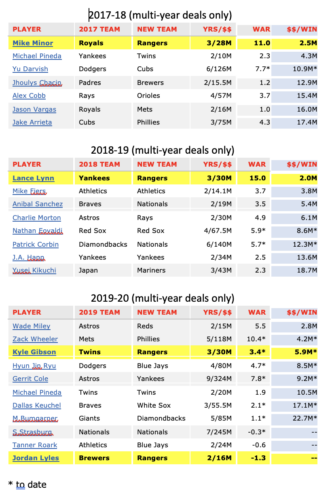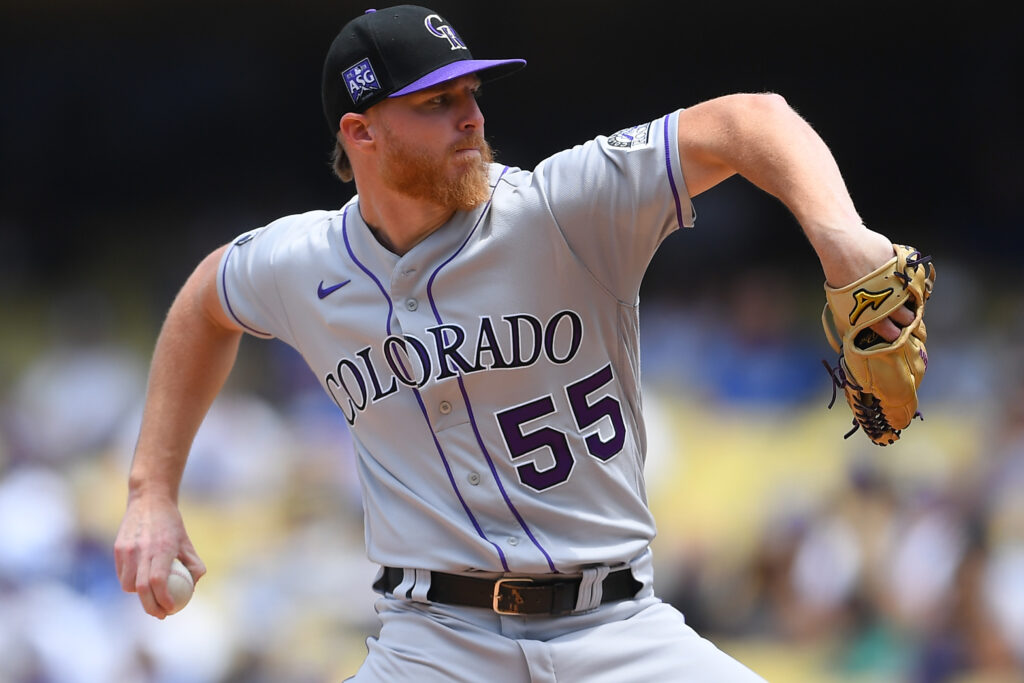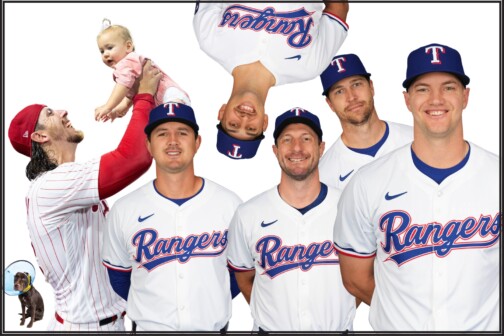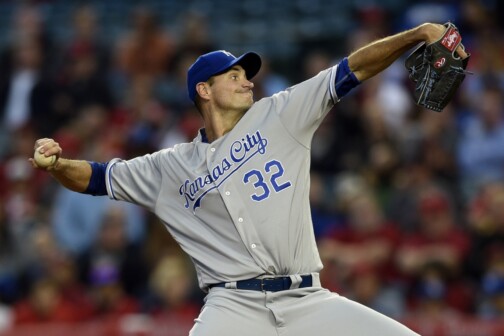As the 2011 Winter Meetings came to a close in Dallas, the Los Angeles Angels shook the baseball world by breaking news that they had signed Albert Pujols to a 10-year, $254 million contract. Almost parenthetically, they also inked C.J. Wilson to a $77.5 million deal for half the term, the biggest contract landed by any pitcher that offseason. Rarely has such a significant free-agent deal been treated as a footnote.
Almost a decade later to the day and 20 miles to the west, the Rangers formally announced the additions of Corey Seager (10 years) and Marcus Semien (seven years) at a combined $500 million. Included as almost a postscript was righty Jon Gray, introduced in a press briefing later the same afternoon after signing on for four years and $56 million, a seemingly incidental 10 percent of the day’s spending spree by the club.
Wilson would prove to be the workhorse of the Angels’ staff before fading and ultimately missing the final quarter (and most expensive portion) of his contract due to injury. Texas envisions even more out of Gray: to become the latest shrewd addition of a pitcher who finds a new gear in Texas. Recent history suggests it’s not an unreasonable expectation.
Things haven’t gone particularly well on the field for the Rangers the last four years, but they’ve done two things really well over that time. The first, capitalizing in the amateur draft, is one you’d certainly hope for, if not expect, from a team annually falling out of the race before the stretch run. The string of losing seasons has armed Texas with picks high in the first round, and with those picks, the club has added Cole Winn (2018), Josh Jung (2019), Justin Foscue (2020), and Jack Leiter (2021) to the system. All four are counted on as major pieces of the rebuild puzzle. Texas will pick third overall this summer, another golden opportunity to fortify the near future with a high-end prospect.
The second accomplishment, however, is not normal for a non-contending team and, historically, not at all normal for Texas. The Rangers—the franchise of Pudge and Juan, of Raffy and A-Rod, of Michael and Kins, of Adrian and Josh—have quietly emerged as purveyors of pitching, and they’ve done it by trawling the middle of the market, not splurging for big-ticket items.
In successive years, the club signed Mike Minor (2018), Lance Lynn (2019), and Kyle Gibson (2020) to multi-year deals. The results were undeniable: as Rangers, Minor (nine years after his major league debut), Lynn (10 years), and Gibson (eight years) each had his highest WAR season, lowered his walk rate, and posted his career lowest FIP (an ERA-like measure that eliminates the quality of the defense behind a pitcher). Lynn and Minor had career-high workloads and swing-and-miss rates, and both earned Cy Young Award votes. None of the three had appeared in an All-Star Game before coming to Texas. All have now.
No free-agent starter in baseball provided more multi-year bang for the buck—or, in the baseball vernacular, a lower cost per Win Above Replacement (WAR)—than Minor did out of the 2018 class. Same goes for Lynn in the 2019 class. Only two, Cincinnati’s Wade Miley and Philadelphia’s Zack Wheeler, have fared better than Gibson among those in the 2020 class.

“The fun part is that each of them were so different,” says Rangers president of baseball operations Jon Daniels. “At different stages of rehab from prior issues. Different repertoires. It’s not one specific thing that a coach specializes in or our systems are good at identifying. That gives us confidence we can continue to help other pitchers at similar stages.”
This offseason, that means Gray. When Daniels, general manager Chris Young, manager Chris Woodward, and pitching coaches Doug Mathis and Brendan Sagara met with the 30-year-old over Zoom, they came prepared with a bandolier of bullet points they could present to support their vision. But they didn’t need to familiarize Gray too much with the success his predecessors had enjoyed in Arlington. “I saw it with my own eyes,” Gray told the media on December 1, just after the Semien, Seager, and Kole Calhoun pressers and hours before the league shut operations down. “[I saw them] come here and do a heck of a lot better. Just knowing that could be my path, it’s very exciting.”
And the Rangers’ pitch went well beyond walking Gray by the Minor-Lynn-Gibson trophy case. They got personal. They talked about specific areas of the righty’s game where they felt they could help him reach a new level—and not just with one of his four offerings (four-seam, 95-98 mph fastball; advanced slider; serviceable curve; effective change). “It was with every pitch,” said Gray, declining to get into specifics. “It was with some things that had been, I guess, my kryptonite over the last couple years, some things [that] I think have slowed me down.”
More important, the Rangers explained it all so that Gray understood it beyond the standard “We can help you be the best you” abstract players are regularly asked to trust. “They [gave] me something I can work with now,” Gray said. “’[This is] how it works, and this is why.’ That was really important to me to see that.”
Rangers officials noted at Gray’s introduction that their scouts—both on the amateur level when he was on the verge of being selected third in the 2013 MLB Draft out of the University of Oklahoma and on the pro side as he advanced through the Colorado system—analysts, and coaches were in lockstep on what Gray is and could be, particularly once he was liberated from the game’s most challenging pitching conditions.
The career Rockie had to deal with a much more taxing test than just pitching in Denver’s high altitude and thin air. Navigating the unique difficulties of going from Coors Field to not Coors Field and back, over and over and over, necessitated constantly shifting between different methods of pitching at home and on the road. (Gray went on to tell the media about how he was forced to change his entire arsenal and attack and even his release point between Coors Field and elsewhere, going so far as having to mechanically throw his curveball two different ways.) Freed of that job requirement, Gray can now focus on learning how to make his pitches more effective, not on how to be a different pitcher in his own ballpark from the one he had to morph into as a visitor.
Young Rangers lefty Kolby Allard probably learned a thing or two from Minor. Taylor Hearn likely picked up on Lynn’s mound demeanor as he tries to enhance his own. Dane Dunning surely paid extra attention to how Gibson worked, on the mound and between starts, as a workhorse relying on location and savvy more than power. As for Gray, every pitcher the Rangers envision as a possible piece of their long-term future has an ETA that should intersect with the four years of his contract term. It’s certain that part of the veteran’s allure is the role he can play mentoring and setting an example for the young pitchers expected to join him in the rotation.
And that’s where Gray’s time in Texas could—or, the Rangers hope, will—differ from Minor’s, Lynn’s, and Gibson’s. None of those other three finished their multi-year deals in Texas, instead getting flipped for minor leaguers with upside. That was the best-case scenario given where the organization was at the time. All made $10 million a year or less, making them extremely tradeable for a rebuilding team as long as they pitched well. They did far more than that, each reaching a new level on the mound while in Texas.
The best case for Gray is different and not just because he landed an extra year and 40 percent more money each season. It’s different because the upside is not rooted in trading him to get younger. Instead, it’s that Gray’s production here—along with the players for whom he served as an undercard a month ago—could help the Rangers finally kick down a door in Arlington instead of kick another can farther down the road.
Author







